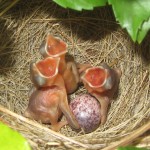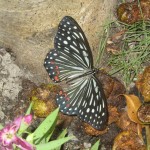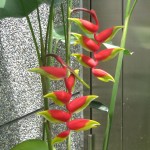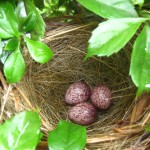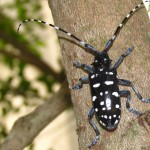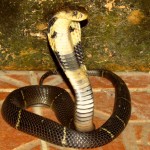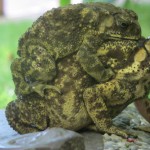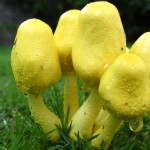Flora and Fauna of Tropical Asia
The fascinating world of tropical nature
Taiwan Bulbul – Hatchlings
The eggs have hatched! Three of the four so far, the fourth one is still intact. The mother bulbul (Pycnonotus taivanus) has diligently incubated them during the past 11 days (despite frequent rains and even a few heavy thunderstorms) and it was such a pleasure to see the baby birds emerge this afternoon! I took just one photo before the mother returned to the nest and I photographed her too – amazingly she wasn’t frightened by me or the camera, even though I held it just 15 centimetres from her face. Maybe she was simply determined to protect… Continue reading
Red Ring Skirt Feeding on Fig
The Red Ring Skirt (Hestina assimilis) is a species of butterfly in the family nymphalidae, commonly found in Asia (from northern Vietnam to southern and eastern China as well as the Korean peninsula, Taiwan and southern Japan). Fairly large, with its wing span of 60 – 80 millimetres, it is an attractive insect that often feeds on the ground, looking for fallen decomposing fruit or a source of moisture. The larvae are commonly found on top of the leaves of the Chinese hackberry tree (Celtis sinensis), taking about three weeks to mature. The adult butterfly… Continue reading
Heliconia Rostrata
Every time I look at a Heliconia rostrata flower, commonly referred to as “hanging lobster claw”, I am instantly reminded of how wonderfully creative Mother Nature really is. Originating from western South America (it is the national flower of Bolivia), this long-lasting flower goes through many phases of life during which it transforms itself from a promising reddish tint on top of the plant’s stem into this majestic attention-drawing marvel. Unlike many other heliconias, which flower throughout the year or several times each year, the rostrata species only bloom once a year, usually in May in this part of the… Continue reading
Taiwan Bulbul – Eggs
The Taiwan Bulbul or Styan’s Bulbul (Pycnonotus taivanus) is an endemic species of bulbul that lives in eastern and southern Taiwan. These birds are very common around Taitung and often set up nests in the taller trees around our house. Recently, however, a pair of them has built theirs in the low bushes of Skyflower (Duranta erecta), right at the entrance of the house! I found this surprising as they must have noticed the rather heavy traffic of people walking in and out – now barely a metre from the nest! Also, the… Continue reading
Asian Long-horned Beetle
Asian Long-horned Beetle (Anoplophora glabripennis) is a spectacular insect, at least in terms of appearance. Its enormous antennae in alternating black and white colours are perhaps the most fascinating – without them it would look fairly ordinary. This is only the second time I spotted this insect in the garden; luckily this time it gave me enough time to get the camera and take some photos before it climbed up the tree and disappeared. The reason for it being so rare is the fact that, although it takes it two years to mature, its adult life then… Continue reading
Chinese Cobra on Visit
It’s the second time this year a Chinese cobra (Naja atra) has paid us a visit. The first time it happened I was mighty excited — and terribly scared — because it was making its way towards the aviary where I keep a handful of parrots. Although this was no King cobra, it was still deadly and I was worried. Eventually the snake did enter the aviary, although I only became aware of the fact four days later when I spotted it again – right next to the small refrigerator where I keep bird food. So for… Continue reading
Mating Spectacled Toads
Duttaphrynus melanostictus is a toad commonly found in south and east Asia, from India and China to Borneo and Sumatra. It is commonly called “Spectacled Toad” or “Javanese Toad”. A nocturnal amphibian, the species often inhabit farmland and human settlements, feeding mostly on insects. Its colours are rather striking, golden with black ridges; this makes them hard to spot on rocks and naked soil, especially in low-light, but they are distinctive when sitting on top of green vegetation. Females are noticeably larger than males, some growing to as much as 20 cm in length and becoming a lot less dynamic… Continue reading
Yellow Garden Mushroom
Leucocoprinus birnbaumii is a fairly common mushroom found in many tropical and subtropical regions, while in temperate climate it can grow indoors, alongside potted plants. Perhaps unsurprisingly, given that the English language is predominantly spoken in the climatically milder zones, it is sometimes called “plantpot dapperling”, “flowerpot parasol” or “yellow houseplant mushroom”, even though in most parts of the world it occurs outdoors. In Taiwan the mushroom is called 純黃白鬼傘, which can be literally translated as “pure white-yellow ghost umbrella”. It is mildly poisonous and it might cause severe stomach problems if consumed.
We usually get these fungi in the… Continue reading
